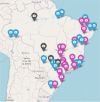Epidemiology of rare diseases in Brazil: protocol of the Brazilian Rare Diseases Network (RARAS-BRDN)
- PMID: 35209917
- PMCID: PMC8867447
- DOI: 10.1186/s13023-022-02254-4
Epidemiology of rare diseases in Brazil: protocol of the Brazilian Rare Diseases Network (RARAS-BRDN)
Abstract
The Brazilian Policy of Comprehensive Care for People with Rare Diseases (BPCCPRD) was established by the Ministry of Health to reduce morbidity and mortality and improve the quality of life of people with rare diseases (RD). Several laboratory tests, most using molecular genetic technologies, have been incorporated by the Brazilian Public Health System, and 18 specialised centres have so far been established at university hospitals (UH) in the capitals of the Southern, Southeastern and Northeastern regions. However, whether the available human and technological resources in these services are appropriate and sufficient to achieve the goals of care established by the BPCCPRD is unknown. Despite great advances in diagnosis, especially due to new technologies and the recent structuring of clinical assessment of RD in Brazil, epidemiological data are lacking and when available, restricted to specific disorders. This position paper summarises the performance of a nationally representative survey on epidemiology, clinical status, and diagnostic and therapeutic resources employed for individuals with genetic and non-genetic RD in Brazil. The Brazilian Rare Disease Network (BRDN) is under development, comprising 40 institutions, including 18 UH, 17 Rare Diseases Reference Services and five Newborn Screening Reference Services. A retrospective study will be initially conducted, followed by a prospective study. The data collection instrument will use a standard protocol with sociodemographic data and clinical and diagnostic aspects according to international ontology. This great collaborative network is the first initiative of a large epidemiological data collection of RD in Latin America, and the results will increase the knowledge of RD in Brazil and help health managers to improve national public policy on RD in Brazil.
Keywords: Epidemiology; Healthcare system; Public health; Rare diseases.
© 2022. The Author(s).
Conflict of interest statement
The authors declare no competing interests.
Figures
References
-
- Richter T, Nestler-Parr S, Babela R, Khan ZM, Tesoro T, Molsen E, Hughes DA, International Society for Pharmacoeconomics and Outcomes Research Rare Disease Special Interest Group Rare disease terminology and definitions—a systematic global review: report of the ISPOR Rare Disease Special Interest Group. Value Health. 2015;18:906–914. doi: 10.1016/j.jval.2015.05.008. - DOI - PubMed
Publication types
MeSH terms
LinkOut - more resources
Full Text Sources
Medical
Miscellaneous




